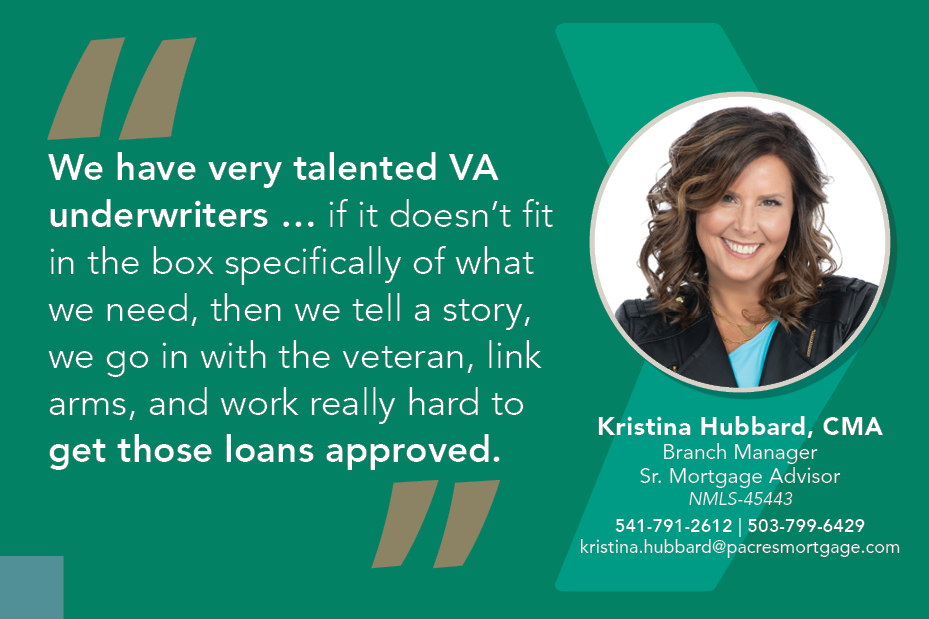Your Questions, Our Answers: Why Today’s VA Loans are a ‘Match Made in Heaven’
Kristina Hubbard, CMA, Branch Manager / Sr. Mortgage AdvisorDecember 12, 2023 — 2 min read

From bacon and eggs to mac and cheese, there are some things that just go together, like if you’re shopping for a home in today’s market and have military homebuying benefits.
Those with military benefits include veterans, active-duty military members, and surviving spouses, a pool of participants that has been growing since the 1990s. However, while it’s estimated that more than one million active-duty troops and 22 million veterans qualify for a veteran’s administration home loan, surprisingly, under 2 million of the 16.4 million veterans who own homes have utilized this benefit.
Just in time for Veteran’s Day, Executive Vice President and Co-Founder of PacRes Mortgage Eric Wiley—who hosts Wiley’s Weekly Wisdom—sat down with Sr. Mortgage Advisor Kristina Hubbard to dig deeper into the benefits of a veteran’s administration home loan and dispel myths that may deter eligible borrowers from utilizing this valuable resource.
Watch the full interview below for a breakdown of their discussion and insights.
Buyer & seller misconceptions
- Many sellers fear that accepting a VA offer will be costly and complicated in terms of financing; however, this notion is not accurate, especially when you’re working with experienced professionals, like PacRes Mortgage and our real estate partners.
- When the lender and the real estate agent are knowledgeable, VA financing becomes a fantastic benefit for the borrower and one of the most valuable advantages veterans have. Click here to learn more.
RELATED: Debunking Mortgage Myths: Learn the Truth Before Buying a Home
How has the VA loan evolved & improved over time
- One of the most exciting developments involves a clearer understanding of the seller's contribution towards a veteran's closing costs. While it was previously thought that sellers could pay 4 percent of a veteran's closing costs, they can actually pay all of the veteran’s closing costs; in addition, the seller can put an additional 4 percent toward any concession, such as the VA funding fee, debt payoff, tax and insurance escrows, or payoff of judgments.
- One other notable change is the waiver of the funding fee for veterans with any disability percentage, even as low as 10 percent. This fee waiver is substantial, especially considering it can be as high as 1.6 percent for first-time use or subsequent use of the loan. Many people overlook this crucial advantage.
- There have also been big changes to debt-to-income (DTI) ratios for this program; traditionally, most lenders aim to keep DTI ratios around 45 percent or better. However, the veteran’s administration has loosened requirements, recently stretching it to 50 or even 55 percent. This allows underwriters to assess each case individually and consider compensating factors.
- Additionally, the program has become more inclusive for veterans who are still building their credit. This flexibility extends further based on compensating factors, enabling a wider pool of veterans to qualify.
RELATED: Not Your Dad’s Note: How Have Mortgages Changed Over the Years?
Is there a surviving spouse benefit?
- Yes, though surprisingly, many people are unaware of it. This benefit is designed to assist eligible surviving spouses of veterans in securing home financing even after the veteran has passed away. While it might not be widely known, it plays a significant role in ensuring financial stability for these spouses during challenging times. Click here to learn more.
RELATED: 10 Facts You May Not Know About VA Home Loans
We balance manual underwriting with new technology
In certain cases, especially when dealing with unique circumstances or compensating factors, the standard automated approval process might not be suitable for veterans; at PacRes Mortgage, we have highly skilled underwriters who can manually underwrite these cases, ensuring that each veteran's individual needs are met.
We collaborate closely with the veteran, putting in extra effort and determination to secure loan approval. Click here to learn more.
What different types of VA loan refinances are available?
Interest Rate Reduction Refinance Loan (IRRRL)
Also known as a VA Streamline Refinance, the IRRRL allows veterans to refinance an existing VA loan to a new loan with a lower interest rate. One of the significant advantages of IRRRL is that usually, no appraisal or credit underwriting package is required, making the process faster and more straightforward.
Interest Rate Reduction Refinance Loan (IRRRL) with Cash-Out
This is a variation of the IRRRL that allows veterans to take cash out of their home equity; however, the maximum loan amount is limited to the outstanding VA loan balance plus allowable fees and closing costs.
Cash-Out Refinance
This type of refinance allows veterans to take cash out of their home equity. It's an excellent option for those who want to consolidate debt, make home improvements, or pay for other major expenses. The new loan amount can be up to 100% of the appraised value of the home.

Ready to take a confident next step? Reach out to your neighborhood Mortgage Advisor today to get started!
Keywords:
Categories
Archives
Recent Posts
- No Down Payment for First-Time Homebuyers
- How Does A 30-Year Mortgage Work: A Simple Guide
- Your Comprehensive Homebuying Checklist: A Step-By-Step Guide
- Mortgage Pre-Approval: Everything You Need to Know
- What Are the Benefits of a USDA Loan for Homebuyers?
- How Many People Can Be On A Home Loan? Your 2024 Guide
You bring the dream. We'll bring the diagram.
There’s a financing solution for just about every situation.
I felt like I was treated like family, great communication and helping me with any questions I had.

You bring the dream. We'll bring the diagram.
There’s a financing solution for just about every situation.
Where does your sun shine? Find your local advisor.
Enter your city or state to see advisors near you.
